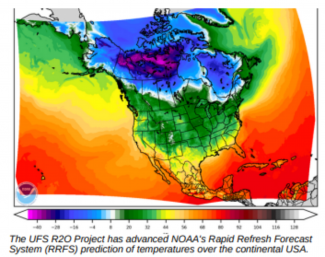The goals of the Unified Forecast System (UFS) are ambitious: construct a unified modeling system capable of replacing dozens of independently developed and maintained operational prediction systems, while simultaneously paving the way for researchers in NOAA labs and the broader NWP community to access and use that system, improve it, and contribute their own innovations.
Toward these goals, the UFS Research-to-Operations (UFS-R2O) project began contributing to the UFS just over a year ago aiming to deliver several systems ready to move into operational mode under a unified framework, including a global coupled ensemble-based system for medium-range and sub-seasonal to season prediction (Global (Ensemble) Forecast System - G(E)FS); an hourly-updating, ensemble-based, high resolution short-range prediction system (Rapid Refresh Forecast System - RRFS); and a hurricane prediction system (Hurricane Application Forecast System - HAFS).
Developing multiple modeling applications under a single, coordinated project is a new way of doing business for NOAA & NWS, and one that is starting to pay off. A key driver of success for the first year of the UFS-R2O project is a commitment to leveraging community infrastructure packages that form the backbone of the entire system. Infrastructure packages span the applications listed above and provide core functions: model coupling, interface between atmospheric physics and dynamics, data assimilation, hierarchical model development and testing, post-processing, and model verification. The infrastructure packages are backed by teams with substantial expertise, each focused on providing robust solutions to some of the most complex challenges in building Earth system models. Examples of community-developed infrastructure used in UFS include the Model Evaluation Tools verification system (METplus), the Earth System Modeling Framework (ESMF), the Community Mediator for Earth Prediction Systems (CMEPS), the Community Data Models for Earth Prediction Systems (CDEPS), the Common Community Physics Package (CCPP), and the Joint Effort for Data assimilation Integration (JEDI).
Use of community infrastructure software has accelerated progress within the UFS. One way this has happened is through greater sharing and reuse of code. Another way is through specialized, focused teams solving complex problems in a generalized way such that multiple applications reap the benefits. For example, the UFS has teamed with ESMF to provide a unified coupling framework capable of supporting a range of different UFS application requirements, from single component configurations to fully coupled. ESMF has been leveraged in a collaborative effort between NCAR and NOAA to develop the CMEPS (a coupler to handle information exchange across different earth system models) as a shared coupler and the new CDEPS (a data model functionality). Both CMEPS and CDEPS are used in NCAR’s Community Earth System Model, and in the UFS Medium Range Weather and Hurricane applications. This approach represents a substantial consolidation of effort. Code optimizations, as well as problems resolved within one system, have been immediately leveraged by another. The use of CMEPS and CDEPS in multiple contexts and by a large user base has increased its flexibility--needed for experimentation by the research community--and robustness--required for reliability when run in operational environments.
Use of the CCPP has accelerated the progress of coupling atmospheric physics and dynamics. The CCPP is a collection of atmospheric physical parameterizations (CCPP Physics) and a framework that couples the physics for use in Earth system models. The CCPP-Physics is designed to contain operational and developmental parameterizations for weather through seasonal prediction timescales. Today the CCPP is used in the UFS and in the Navy’s next generation model NEPTUNE (Navy Environmental Prediction sysTem Utilizing the NUMA corE). Additionally, the CCPP Framework is being extended for use with the NCAR Model for Prediction Across Scales (MPAS) and Community Atmospheric Model (CAM). Because it enables host models to assemble parameterizations in flexible suites, and is distributed with a single-column model that permits tests in which physics and dynamics are decoupled, the CCPP facilitates hierarchical system development and is appropriate for both research and operations.
The infrastructure not only includes the physics, model, and coupling framework, but also the pre-processing, post-processing, and verification and diagnostics tools. METplus is the UFS verification and validation tool that draws contributions from within the community, including academia, laboratories, and operational centers. It has a full suite of traditional statistics and is now being expanded to support diagnostics used in model development at all spatial and temporal time scales. These enhancements are being driven by the findings of the 2021 DTC UFS Metrics Workshop, held in February 2021. METplus is also being integrated into the UFS application workflows to be run after the Unified Post Processor (UPP) interpolates the model output onto standard grids. Finally, it has also been extended to leverage the output of JEDI for evaluations using the observation dataset ingested by JEDI.
Overall, the interdependency of the infrastructure packages are beginning to show a maturity and robustness that will lead to efficient model improvement for the UFS over the next few years. The second year of the UFS-R2O project is staged to continue to accelerate the development of an efficient, flexible, and well supported cross-cutting infrastructure.
